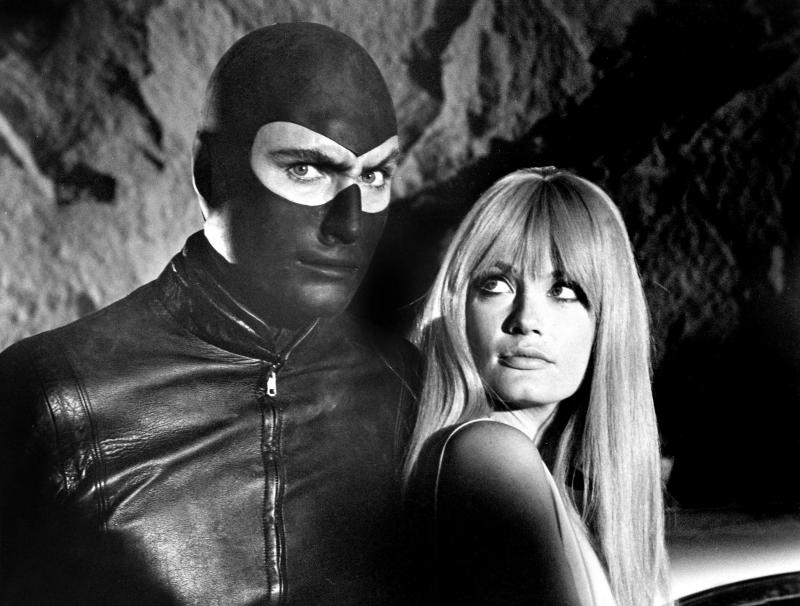
DANGER DIABOLIK

DANGER DIABOLIK
Mario Bava, 1968, Italy / France, 105'
Sceneggiatura / Screenplay: Mario Bava, Tudor Gates, Brian Degas, Dino Maiuri, story by Angela & Adriana Giussani
Produttore / Producer: Dino De Laurentiis
Interpreti / Cast: John Phillip Law, Marisa Mell, Michel Piccoli, Adolfo Celi
Musica / Music: Ennio Morricone
Diabolik l'uomo del mistero e la sua sensuale amante Eva Kant passano di rapina in rapina, mentre i poliziotti europei guidati dall'ispettore Ginko e gli invidiosi gangsters guidati da Ralph Valmont si stanno avvicinando a loro...
Man of mystery Diabolik and his sensuous lover Eva Kant pull off heist after heist, all while European cops led by Inspector Ginko and envious mobsters led by Ralph Valmont are closing in on them...
Mario Bava (1914 – 1980)
Il padre di Mario Bava, Eugenio Bava (1886-1966), fu un famoso direttore della fotografia agli albori dell'industria cinematografica italiana. Mario si formò come pittore e, quando alla fine seguì le orme paterne nel campo della cinematografia, il suo background artistico lo portò a credere fortemente nell'importanza della composizione visiva, costruendosi una forte reputazione come un genio degli effetti speciali. Tra i registi per i quali Bava ha lavorato ci sono Riccardo Freda, Jacques Tourneur e Raoul Walsh. Mentre lavorava a I vampiri (1957), Freda lasciò il progetto dopo una discussione con i produttori, Bava passò alla regia e lo completò. Questo film ha ispirato l'ondata di film gotici italiani di cui Bava fu maestro: La maschera del demonio (1960) è uno dei suoi lavori più noti. Ma mentre Black Sunday è un film in bianco e nero, è col colore che Bava eccelle. I film che seguirono svilupparono una fotografia straordinaria, con un grande uso di illuminazione, scenografia e posizionamento della camera per complementare la messa in scena. Opere come La frusta e il corpo (1963), Terrore nello spazio (1965), Operazione paura (1966), Reazione a catena (1971) e Lisa e il diavolo (1973) assumono l'aspetto di vere opere d'arte. Film come La ragazza che vuole troppo (1963) e Sei donne per l'assassino (1964) hanno creato lo stile e la sostanza del giallo. Bava lavorò in molti generi popolari, film di vichinghi, peplum, spaghetti western, azione e persino softcore, ma sono i suoi film horror e gialli che si distinguono, i lavori per cui è ancora ricordato oggi, anche da registi come Tarantino e Refn. Con la sua morte un'era del cinema italiano si è chiusa.
The father of Mario, Eugenio Bava (1886-1966), was a cinematographer in the early days of the Italian film industry. Mario was trained as a painter, and when he eventually followed his father into film photography his artistic background led him to a strong belief in the importance of visual composition, developing a reputation as a special effects genius. Among the directors for whom Bava worked were Riccardo Freda, Jacques Tourneur and Raoul Walsh. While working on I vampiri (1957), the director Freda left the project after an argument with the producers, Bava stepped in and finishing it. This film inspired the italian gothic films wave and Bava was the Master of it: Black Sunday (1960), is one his most well known. While Black Sunday is a black and white film, it was in the color milieu that the director excelled. The projects which followed began to develop stunning photography, making great use of lighting, set design, and camera positioning to compliment mise-en-scenes. Works such as The Body and the Whip (1963), and Planet Blood (1965), Operation Fear (1966), Bay of Blood (1971), and Lisa and the Devil (1973) took on the look of works of art. The Evil Eye (1963) and Sei donne per l'assassino (1964) created the style and substance of the giallo. Bava worked in many popular genres, including viking films, peplum, spaghetti westerns, action, and even softcore, but it is his horror films and giallo mystery films which stand out and for which he is best remembered, even by director as Tarantino and Refn. With his death, an era in Italian filmmaking had come to a close.